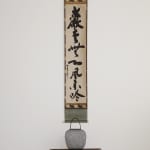Gyokushū Sōban (1600−1668)
Zen Verse
Ink on paper, hanging scroll
With authentication by Okura Kosai
Seals: Yuyu jizai, Shingen itteki, Shunsui
128 x 27.5 cm
204 x 30 cm (overall)
With authentication by Okura Kosai
Seals: Yuyu jizai, Shingen itteki, Shunsui
128 x 27.5 cm
204 x 30 cm (overall)
Further images
Literature
Daitoku-ji ichigyo meihinshu. Tokyo: Kyuryudo, 2000.
The verse written in this work reads: “A lonesome pine tree stands on the rocks as if through the eons. Its branches and leaves rustle in the pure wind.” There exists no intentional acts; both the pine tree and the wind are just being in the state of “mushin,” or “mind without mind.” The term “mushin” refers to the meditation status of being free from any kind of emotions or intellectual thoughts, a status that surpasses the sacred and the secular. Resonant with the human life, the unwavering pine tree in this verse suggests a way to the great enlightenment.
Ever since Murata Juko, founder of the Wabi-cha style, underwent Zen training there, the Daitoku-ji Temple has established a close connection with Chanoyu. From then on, calligraphy by the Daitoku-ji priests became significant hanging scrolls for tea ceremonies. Gyokushu Soban is the 185th abbot of Daitoku-ji Temple. He was trained under Gyokushitsu Sohaku, and became the second abbot of Hoshun-in. He was appointed the founding abbot of Jiko-in Temple in Yamato, and established Korin-an in Daitoku-ji Temple. Besides, he once took the seat of abbot of Tokai-ji Temple in Shinagawa, Edo, in rotation. Later he was designated the title of Daitetsu myo’o Zenji by Emperor Gosai. In the present work, the brushworks achieve a balance between wittiness and solidness that is resonant of wind rustling among the pine tree leaves. His restrained, even artless writing style can also be said to have reached the “mushin” status.
Gyokushu Soban (Zen priest; 1600–1668)
Also known as Seika Sanjin, Shunsui, Yuyujizai, and Zenzai.
Yamashiro-born early Edo period Rinzai School Zen priest. His real family name is Ito. Gyokushu is his Buddhist name, and Soban is his true name. The 185th chief abbot of Daitoku-ji Temple. Inherited the teaching of Gyokushitsu Sohaku, and became the second chief abbot of Hoshun-in, a sub temple of Daitoku-ji. The first chief abbot of Jiko-in Temple of the Yamato-koizumi feudal clan, and founded Korin-an at Daitoku-ji. Later became the chief priest at Musashi Shinagawa Tokai-ji Temple on rotation. He was given the Buddhist name Daitetsu myo’o zenji posthumously.
Ever since Murata Juko, founder of the Wabi-cha style, underwent Zen training there, the Daitoku-ji Temple has established a close connection with Chanoyu. From then on, calligraphy by the Daitoku-ji priests became significant hanging scrolls for tea ceremonies. Gyokushu Soban is the 185th abbot of Daitoku-ji Temple. He was trained under Gyokushitsu Sohaku, and became the second abbot of Hoshun-in. He was appointed the founding abbot of Jiko-in Temple in Yamato, and established Korin-an in Daitoku-ji Temple. Besides, he once took the seat of abbot of Tokai-ji Temple in Shinagawa, Edo, in rotation. Later he was designated the title of Daitetsu myo’o Zenji by Emperor Gosai. In the present work, the brushworks achieve a balance between wittiness and solidness that is resonant of wind rustling among the pine tree leaves. His restrained, even artless writing style can also be said to have reached the “mushin” status.
Gyokushu Soban (Zen priest; 1600–1668)
Also known as Seika Sanjin, Shunsui, Yuyujizai, and Zenzai.
Yamashiro-born early Edo period Rinzai School Zen priest. His real family name is Ito. Gyokushu is his Buddhist name, and Soban is his true name. The 185th chief abbot of Daitoku-ji Temple. Inherited the teaching of Gyokushitsu Sohaku, and became the second chief abbot of Hoshun-in, a sub temple of Daitoku-ji. The first chief abbot of Jiko-in Temple of the Yamato-koizumi feudal clan, and founded Korin-an at Daitoku-ji. Later became the chief priest at Musashi Shinagawa Tokai-ji Temple on rotation. He was given the Buddhist name Daitetsu myo’o zenji posthumously.







